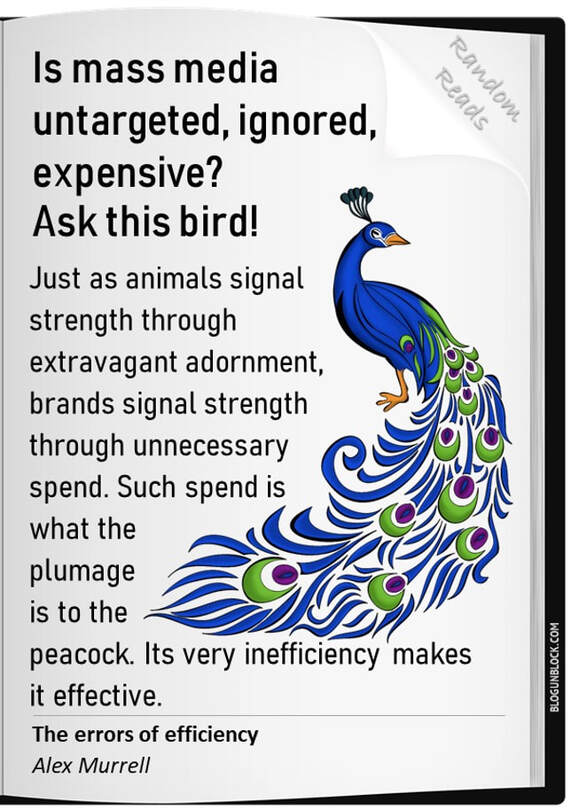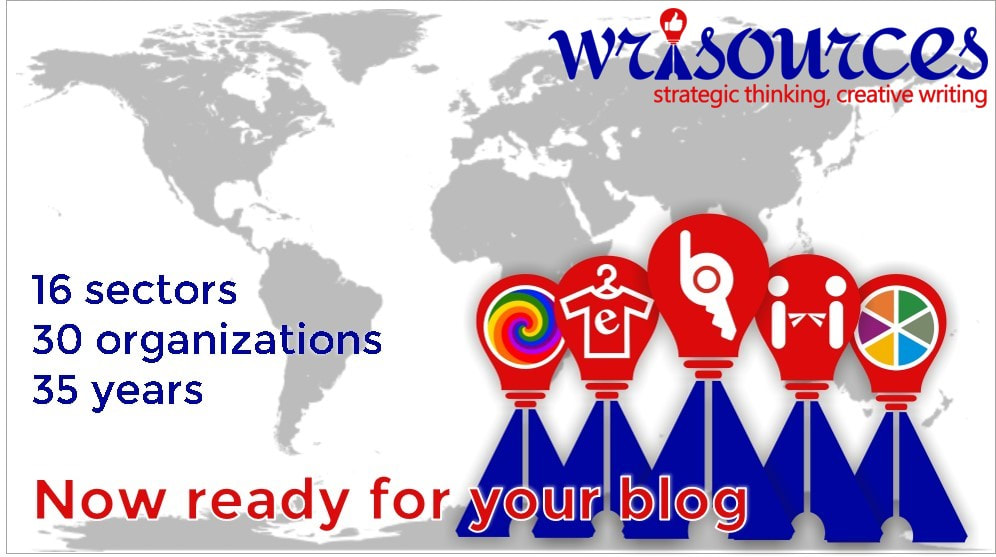|
We live in the era of efficiency. We want our teams to be lean. Our processes to be agile. And our output to be optimised. Instead of maximising our impact, we aim to minimise our waste. In the search to remove redundancy, marketing perceives paid social media and online video as cheap, able to reach defined audience and provide measurable response. Traditional broadcast communications are thought to be an inconceivable indulgence: they are mass, ignored and expensive. This article argues that efficient doesn’t necessarily mean effective, that more productive doesn’t necessarily mean more powerful, and that being mass, ignored and expensive are not points of weakness but, in fact, points of strength. Error 01: Mass media is wasteful because it is untargetedWhen you communicate on mass media, whether it’s a 30-second spot on prime-time TV, a press ad in a national newspaper, or a 6-sheet in a city centre, you will reach a large number of those who are in your target market. But you will also reach a large number of those who are not. Imagine, for example, that you’re advertising a luxury car. Broadcast communications will inevitably reach those who are too young to drive, those who are too old, those who don’t have a driver’s license, those who rely on public transport, those who are banned from driving and those who can’t afford a premium vehicle. But considering these segments to be ‘waste’ ignores one the most foundational roles that brands perform. It ignores the idea that brands not only provide functional and emotional benefits, but self-expressive ones. By driving an expensive brand of car, the owner communicates their financial status. The car’s design might communicate their sense of style. And its provenance might communicate their sensibilities. The fact that everybody understands what the brand represents makes it a more effective signal of what the buyer represents. Advertising to those who cannot afford the brand makes the product more appealing to those who can. For a potential audience to buy the brand, they have to know that a much wider audience aspires to do the same. Traditional broadcast communications not only reach a large audience, they reach that audience publicly. In mass media, not only do many people see your advert, but they see many other people see your advert as well. When you broadcast your brand, everybody knows that everybody else knows what you stand for. To summarise, yes traditional communications are mass, but that does not make them wasteful. Mass media reaches a large audience, imprinting brands on culture and imbuing them with self-expressive benefits. Error 02: Mass media is wasteful because it is ignored'It’s easy to see how low-attention communication channels could be seen to be inefficient. If two-thirds of each TV ad doesn’t receive active attention, isn’t that two-thirds of spend that is wasted? A group of contrarian researchers believes that the answer is no. The academics argue that when it comes to brand building, low attention equals high value. In 1964, Leon Festinger partnered with his colleague Nathan Maccoby to understand how people process messages during periods of distraction. A summary of the experiment appears in the book, The Choice Factory: “Festinger and Nathan Maccoby, academics at Stanford University, recruited members of college fraternities. They played those students an audio argument about why fraternities were morally wrong. The recording was played in two different scenarios: students either heard it on its own or they watched a silent film at the same time. After the students had heard the recording, the Stanford psychologists questioned them as to how far their views had shifted. Those who had heard the argument at the same time as the silent film were more likely to have changed their opinion." The silent film provided a distraction which reduced the level of attention that was applied to the audio argument. But rather than decrease the argument’s potency, it increased its power. The psychologists hypothesised that participants in the undistracted, high-attention group were able to generate counter-arguments that maintained their existing opinions and avoided the discomfort of experiencing cognitive dissonance. In the low-attention group, on the other hand, the participant's cognitive defences were not invoked and their ability to counter-argue hampered. [Paul Feldwick, author of The Anatomy of Humbug: how to think differently about advertising] summarises the argument beautifully: "When we don’t notice we are being influenced, we cannot argue back." Dr. Robert Heath, author of Seducing the Subconscious summarises: “My theory is that the most successful advertising campaigns in the world are not those we love or those we hate, or those with messages that are new or interesting. They are those (…) that are able to effortlessly slip things under our radar and influence our behaviour without us ever really knowing that they have done so. And the way in which these apparently inoffensive ad campaigns work is by 'seducing' our subconscious.” Michael Shudson, author of Advertising: The Uneasy Persuasion, concludes: “Ads may be more powerful precisely because people pay them so little heed that they do not call critical defences into play.” Error 03: Mass media is wasteful because it is expensiveDarwin’s theory of evolution stated that small mutations made individual animals more or less suited to their environment. Those whose traits benefited them would be more likely to survive, whilst those whose variations hindered them would fall foul of the opposite fate. Over time, species would evolve, converging towards an optimal set of natural abilities. But one thing puzzled Darwin. Why have some animals evolved with attributes that seem to have no functional utility? Why do some, even, have attributes that seem to hinder, not help, their survival. Darwin soon found his answer. He realised that evolution relied not just on which animals survived, but also on those which reproduced. Darwin deduced that the traits that he had perceived to be impediments to survival, were actually advantages when it came to sexual selection. Those who prospered despite their physical encumbrances, he believed, must be stronger, and thus more attractive mates. Or to put it another way, sexual partners deduce that the animals who waste resources must have enough resources to waste. But how does the field of biology relate to the world of business? In 2004 the marketing icon Tim Ambler published a landmark paper in The Journal of Advertising Research that drew a direct connection between the way that animals and brands signal their strength. Both, he argued, communicated through conspicuous waste: “Evidently, just as a female peacocks are drawn to mate with the largest, most spectacular tail feathers because the display signals superior biological fitness, consumers are attracted to brands that invest in lavish displays like Super Bowl commercials because such extravagance signals a high-quality, successful brand.” Ambler hypothesised that just as animals signalled their strength through unnecessary adornment, brands signalled their strength through unnecessary spend. The extravagant spend is to the brand what the plumage is to the peacock. It is its very inefficiency that makes it effective. Expensive media signals brand strength. Inefficient communication carries a “costly signal” that the brand being advertised is of high quality, that it is in strong financial shape, and that it is likely to continue being strong and successful for the foreseeable future. To test this theory, Thinkbox asked over 3,500 people if they perceived brands to be “high quality”, “financially strong” and “confident” when seeing them advertised in various media channels. TV, the archetypal expensive media channel, scored 43%, 50% and 58% respectively. Social media, on the other hand, scored significantly lower at 19%, 21% and 40%. The research suggests a broader truth. On every single metric expensive, traditional media (TV, newspapers, magazines and radio) outperformed cost-efficient digital channels (social media and video sharing sites). Rory Sutherland sums up in Alchemy: “The potency and meaningfulness of communication is in direct proportion to the costliness of its creation (…). This may be inefficient – but it’s what makes it work.” Just as a peacock’s plumage signals strength, and the battlements of British banks signal trustworthiness, expensive media signals the same for brands. Broadcast communications cannot target specific segments. But they can imprint brands on culture and imbue them with self-expressive benefits. Mass media cannot command the most attention. But it can bypass an audiences’ cognitive defences and lodge a brand in the audience’s long-term memory. Traditional channels cannot compete when it comes to cost. But they can use expensive media to signal the strength, security and stability of the brands that advertise on them. As Tim Ambler famously put it: “The waste in advertising is the part that works.” Adapted from the article The Errors of Efficiency by Alex Murrell accessed at https://www.alexmurrell.co.uk/articles/the-errors-of-efficiency
Image: https://cliparting.com/free-peacock-clipart-32777/
0 Comments
Leave a Reply. |
Vijayakumar Kotteri
Abstracts from works of different authors. Archives
November 2021
Categories |


 RSS Feed
RSS Feed






